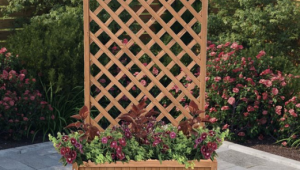Jump to:
Wood has been around far more than people first learned to use it. As a building material, woods were applied as supports for tent-like structures in Britain dating back to 7000 BC. And to this date, 1 billion tonnes of woods are consumed annually around the globe, as compared to its iron and steel counterparts.
But what makes wood an exceptionally popular choice of material for home structures and garden furniture to large production facilities? And how do we make the best of this product for longer purposes and value?
This article will guide you through the basics of wood and help you explore the different types of wood according to their identifying features and best applications.
The many uses of wood
Wood is highly suitable for a wide range of applications other than construction. Because of its efficiency, versatility, and durability, this tree-produced supply makes for a great home and commercial use.
Wood in our homes
- Home and garden structure. Among the earliest use of wood is domestic construction, and this custom lives on to this highly modernised times of steel-made buildings. Housing in different parts of the world is commonly built out of timber– from the flooring, doors and window frames and roof support– all thanks to its strength and insulation properties. Garden structures also make use of some wood types that can withstand the harsh outdoor condition.
- Furniture. No one can argue about the aesthetic appeal of wooden furniture. It reveals a certain kind of warmth and classical element in any given place. Furniture that can be made from this material include almost all interior sets and some exterior.
- Hand Tools. The main parts of most common hand tools may be metal but their handles remain to be of wood, due to the strength and ability it lends to absorb shock and vibration.
- Utensils. Kitchenware and utensils made of wood were a home staple until the rise of metal- and plastic-made kitchen sets.
- Toys and sports equipment. Wooden toys are less hazardous for kids to use and play with than plastic, making it a better option for toys manufacturing. Most sports implement have long made use of wood for handles and main parts.
- Musical instrument. The application of wood in many musical instruments can never be replaced with any other material as wood can be designed to transmit and amplify sound more effectively.
Commercial and large-scale uses
- Shipbuilding. Ships are also among the early forms of wooden structures until the late 18th century, but wood continues to be a common material for rural fishing boats.
- Fuel. Wood remains to be a top source of energy worldwide. Half of Europe’s renewable-energy consumption comes from all forms of wood fuel from sticks to pellets, sawdust, and charcoal.
- Paper. Wood sources out pulp which is then used for producing paper materials like newspapers, magazines, and even toilet paper.
Hardwood and Softwood: What are they?
You’ve heard about hardwood and softwood when referring to or buying wooden products. These two are the major classification of wood as recognised worldwide. The names, however, do not refer to the physical hardness or softness of the wood but on the type of tree from which they are taken.
Hardwood
- Wood that comes from deciduous trees or those that tend to fall off their leaves in due season, particularly autumn and winter. These trees are also commonly broad-leaved.
- Examples include oak, teak, walnut, birch, mahogany, maple, and hickory.
- This class of wood is more abundant in number and species and is widely imported for various range of uses.
Softwood
- Wood that comes from coniferous trees or those that grow up and high and of triangular shapes. Their leaves are either long, pointed needles or long, flat-scaled, and are kept intact until they are old enough to shed.
- Examples include cedars, firs, cypress, juniper, spruce, pine, and redwoods.
- There are about 600 species of conifers, which can survive cold temperatures and acidic soil.
Up-close with different types of woods
Why the need to learn about each particular wood type?
Almost any kind of wood may be used as furnishing material, but the quality and finish of the product will depend highly on the type of wood used. Each timber has its own distinct feature, strength, texture, and colour. As a consumer, it is best to decide on what wood to choose for your furniture before purchasing.
Now let’s get to know more about each of these great species of woods, both native and non-native to the UK.
| NAME | QUICK FACTS | FEATURES | BEST USES |
Ash | Scientific name: Fraxinus sppCountry of origin: Europe and North America Degree of use: High | -Hard and strong wood, and known for its ability to bend-Less expensive than other hardwoods and a good substitute for white oaks -Colour can vary from dark to pale brown and white | -Used as low-end wood furniture as well as frame and panel works-Also good for sports equipment and tool handles |
Beech | Scientific name: Fagus spp.Country of origin: Europe and North America Degree of use: High | – Known for moving and shrinking in the solid and makes an excellent wood to steam bend- Works beautifully when dried – Light brown to pale colour | – Usually used as frames for furniture and woodworking tools- Also used in musical instruments |
Birch | Scientific name: Betula spp.Country of origin: Europe and North America Degree of use: Low | – Has a striking grain pattern and is easy to work with- Comes in light brown to yellowish variety and white | – Used in almost any kind of furniture and home accessories, including cabinets and drawers |
Cedar | Scientific name: Thuja plicataCountry of origin: North America Degree of use: Low | – One of the popular woods due to its beauty, durability and lightness- Has a distinct pleasant aroma and for which make it repel moth – It can also handle moist environment without rotting – Colours range from red to medium and dark tinge | – Used in making elegantly crafted cabinets and chests- Also used for building exteriors such as patio and decks |
Cherry | Scientific name: Prunus spp.Country of origin: Europe and North America Degree of use: Low | – One of the popular and all-around wood- Wood grain is resistant to warping, stains, and finishes well even with oil alone – Has an almost white outer portion and reddish tinge in its heartwood | – Commercially used for making fine furniture, decorative works and musical instrument- Also used as veneer over less expensive wood materials |
Elm | Scientific name: Ulmus spp.Country of origin: Europe and North America Degree of use: High | – Well-known for its durability and ability to bend- This species has a depth of beauty that makes for an expensive product – Colour range from light to dark brown | – Used in making outdoor and indoor furniture pieces and joinery |
Fir | Scientific name: Pseudotsuga taxifoliaCountry of origin: Europe and North America Degree of use: High | – Also known as Douglas Fir, this is a giant tough tree and is water-resistant- Has a distinct pattern which can be perfectly accentuated by a good stain – Colour range from golden to reddish brown | – Used in cheap furniture and plywoods and when a product is intended to be paint-finished |
Hickory | Scientific name: Carya spp.Country of origin: North America Degree of use: Low | – Extremely hard, durable and heavy- Colour ranges from slight red to brown | – Best used for heavy furniture pieces and as veneer- Can also be used for sports implement |
Mahogany | Scientific name: Swietenia macrophyllaCountry of origin: Central and South America Degree of use: High | – Characterised as strong, durable, and warp-resistant wood- Features beautiful red inlays and distinctly straight grain patterns – Takes stains very well and can be finished with oil coating | – One of the top choices for fine furniture pieces and as veneer |
Maple | Scientific name: Acer spp.Country of origin: North America Degree of use: Low | – Comes in hard and soft varieties but both types are very dense and strong than many other types of wood- Has fine, straight grain – Light brown in colour | – Perfect for house flooring and even bowling alleys |
Oak | Scientific name: Quercus spp.Country of origin: Europe and North America Degree of use: High | – One of the most abundant wood materials and fits to several purposes- Has attractive grain patterns; durable and bends well – Comes in red and white varieties | – Used in flooring, making cabinets, fence post, and even boats |
Pine | Scientific name: Pinus spp.Country of origin: Europe and North America Degree of use: High | – A strong kind of softwood and is lightweight- Relatively softer than its varieties which makes it easy to carve – Has straight grain patterns that add uniqueness to furniture product | – Widely used in furniture making such as boxes and cabinets and house construction |
Poplar | Scientific name: Populus spp.Country of origin: UK, Europe Degree of use: Low | – Though the grains are undistinguished, this wood is resistant to stain- Relatively soft and easy to work with – Creamy white in colour with some green or brown streaks in the heartwood | – Used in making cheap furniture products and is almost always finished with paint- Also used for matches and minor craft goods |
Redwood | Scientific name: Sequoia sempervirensCountry of origin: North America Degree of use: LowDegree of use: Low | – A light softwood and has straight grain- Has the ability to resist moisture, pests, and decays – As the name suggests, this wood has a reddish tint | – Best used for fences and outdoor furniture |
Rosewood | Scientific name: Dalbergia spp.Country of origin: Africa, South America, India Degree of use: Low | – An expensive kind of hardwood that comes in various species- Though prone to surface splits, this wood is much sought-after for its beauty – Has a dramatic colouring of red and black streaks | – Used in art creations, musical instrument, and some home furniture |
Teak | Scientific name: Tectona grandisCountry of origin: Southeast Asia Degree of use: High | – Highly resistant to moisture, warping, cracking, and decay- Contains natural oil from its pores that enables it to withstand harsh conditions – Has dramatic colouring of golden brown to dark brown | – Best used for garden and outdoor furniture products |
Walnut | Scientific name: Lovoa trichilioidesCountry of origin: West and Central Africa Degree of use: Low | – Has distinctively fine grains and easy to work with- Colour is deep brown with dark streaks | – Used for making panels and as accents or inlays for wood products |
Yew | Scientific name: Taxus baccataCountry of origin: Europe Degree of use: Low | – Has extraordinary elastic properties- Some varieties could live for a thousand years | – Long been in use for Windsor chairs and long bows and as a decorative veneer |
Wood as furniture choice: Pros and Cons
We have learned that woods are used extensively at home and in different industries. So what makes it a good choice? Or not?
Advantages
- Producing wood costs low and needs smaller amount of energy.
- Wood is an environmentally-friendly material.
- Wood is a renewable material; that is, if new trees are grown when cutting down some for production.
- Wood is a relatively strong material.
- Wood’s low density makes it easier for the product to transport.
- Wooden constructions and furniture are easier to build and work on.
- Wood has a natural aesthetic look and feel.
- Wood makes a good insulator, and thus, an energy-saver.
- Most woods emit zero electrostatic charge and are non-toxic.
- Wood disposal costs less or none at all.
Disadvantages
- Some wood types decrease in strength when wet; making it unstable.
- Wood is susceptible to termites, woodworms, and infestations.
- Wood is susceptible to rot and disease.
- Wood is highly combustible and can’t be used at high temperatures.
- Wood is susceptible to warping as age, temperature, and humidity change.
How to care for wooden products
Considering the pros and cons of wooden materials, proper care and maintenance will spell a great difference to the wood’s lifespan.
And by proper care we mean, primarily, to get specific cleaning guidelines for your purchased wood products. The instructions usually depend on the kind of finish on the wooden material. So applying a wrong cleaning method may do more damage than good to the wood.
Standard cleaning procedures, however, can be applied to protect your wood or minimise the damages.
Basic maintenance
- Handle with care. Damage of material may not only be caused by weather and other elements, but also by improper use and handling.
Useful Tips:
– When picking up furniture, find its strongest portion and carry it from that point, with a firm grip.
– Moving furniture must be carried out at a slower pace.
- Protect from heat and moisture. Wood naturally contains moisture that has to be kept at good balance in order to preserve the material.
Useful Tips:
– Place your wooden furniture away from heating vents, fireplaces, and radiators.
– Don’t store them in places where temperature and humidity constantly vary.
– Most outdoor furniture are made to withstand the weather but best to cover them when not needed.
– Avoid placing sweating glasses or hot dishes on wood without supporting mats or tablecloth.
- Dust frequently. It won’t hurt to give your wooden pieces frequent dusting. This will help remove any deposits from building up on the furniture. Use classic feather duster, lambs-wool duster or dry towels and cloth.
Useful Tips:
– To avoid scattering dust, dampen a cloth slightly and gently rub on the furnishing.
– Follow the wood grain as you dust to avoid cross-grain scratches.
Preserving wood with Finishes
- Polish or wax, but not both. See the manufacturer’s guideline for polish or wax application. Polish is made of petroleum distillates and evaporates quickly when applied. Wax, on the other hand, is a semi-solid product that provides longer protection. Both, however, are soft, warm finishes that produce a subtle, matte sheen on the wood.
Useful Tips:
– Apply wax or polish moderately or as recommended by the manufacturer.
– Apply only when wood has been cleaned with mild soap and dried well enough.
– Re-wax or re-oil a furnished wooden material depending on the wear and tear that the furniture get.
- Lacquer, varnish, shellac. These finishings provide a hard, protective layer that are typically high- or semi-gloss. Consult also the product label for appropriate solvents, time span between coats, and precautions on use.
Useful Tips:
– Make sure that the wood surface has been dusted off and cleaned thoroughly before applying finishes.
– Apply the finishing only with a good quality brush or spray gun.
– Re-apply only when the wooden product is severely damaged.
Wood Waste: To dispose or reuse?
Old or damaged wood, with its size and built, may be considered a bulky waste. But would you set it aside for other uses? Or dispose it for good?
Experts’ recommendation:
- Reuse
– Sort out large wood wastes like timbers, planks, and flooring if still in good shape.
– Also set aside smaller pieces of untreated woods for potential reuse or DIY projects.
– Consider donating or selling your used wooden items.
- Recycle
– Unused wood furniture or pallets may be turned into other items like tables, cabinets, and bird’s nests.
– Shave or saw untreated wood and mix to your compost heap to decompose naturally or apply as mulch.
– Fire up woods and collect the ashes to de-stain pavings, control pond algae, or block garden pests.
- Dispose
– Contact your local waste management on how to dispose of your treated woods.
Resources:
The Structure and Mechanical Behaviour of Wood http://www.doitpoms.ac.uk/
Wood Investigation http://www.heritagewoodsonline.co.uk/
Wood http://www.explainthatstuff.com/
Different Types of Woods http://www.falcon18.com/
Beautiful Wood http://www.finefurnituremaker.com/
Different Types of Wood Timber by A to Z https://www.foe.co.uk/
Timber Architecture: 10 Benefits of Wood-based Designs https://freshome.com/
Caring for Furniture http://www.hgtv.com/
How Do I Recycle Wood? http://homeguides.sfgate.com/
10 Uses of Wood Ashes http://www.thisoldhouse.com/toh/
Wood Furnishings Care http://www.bhg.com/














What do you think ?